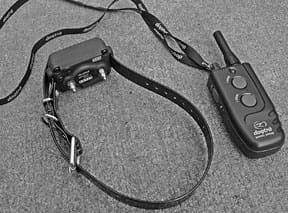Because we feel deeply that dog training should be pleasurable and effective, and because we have personally witnessed innumerable successful demonstrations of completely pain- and fear-free training, we have taken the position that training tools and methods that inflict pain are inferior (a strong word, we know) to those that do not.
We have a history of speaking out against training tools and methods that are, arguably, capable of hurting or scaring dogs (please note that we offer alternatives to these tools and methods in every issue). Recently, we mentioned that we thought it incongruous that two of the largest so-called “humane” organizations in the world had formed professional alliances with companies that make and sell electronic training collars (“What’s a Seal of Approval Worth?” WDJ October 2000).
However, the enduring popularity of these collars makes it clear that many people see nothing wrong with the collars. Lots of people swear by them – including some professional trainers, veterinarians, and experienced competitors in canine sports.
Dr. Phyllis Giroux has all three of the above-described credentials. She graduated from Michigan State University as a Doctor of Veterinary Medicine and a Masters degree in Animal Behavior, and later became a certified Canine Animal Chiropractor. According to her biography, Dr. Giroux has special interest in integrated canine medicine, including chiropractic, homeopathy, herbal medicine and acupuncture. She has been active in purebred dog events in breed, obedience, and field since 1974, and has owned numerous breed champions, earned many obedience titles, working certificates, and has owned and campaigned Retriever Field Champions, Master Hunting Retrievers and Master Hunters. She currently co-owns and operates Deep Run Canine Health Care and Training Center in Goldvein, Virginia, with a business partner, Jack Jagoda.
As you may have guessed by now, Dr. Giroux wholeheartedly advocates the use of electronic training collars. Recently, she and Jagoda completed the first in what they anticipate to be a series of instructional videotapes on the subject of training dogs with the help of electronic training collars. Produced in association with PetSafe, maker of “remote training systems,” the videotapes will demonstrate and explain the trainers’ methods and philosophies. Dr. Giroux was kind enough to forward a copy of the first tape prior to its official release so that we could review it.
We found the tape to be very professionally produced, concise, and informative. The training advice offered and demonstrated by Giroux and Jagoda was sound and reasonable – if you’re not opposed to the use of electronic training collars, which we still are.
Are we being stubborn? Closed-minded? We hope not. We readily admit that the intelligent and restrained use of the collars can produce the desired effect – dogs who perform certain tasks when asked. We can even see how the collars could be used to elicit a response from a dog who would be unreachable in any other way – loose, at a distance, and in the midst of a spontaneous charge toward certain dangers, a busy road, for instance.
But we still feel that there are other training tools and methods that can produce dogs that are trained just as (if not more) quickly and reliably, with absolutely no fear, pain, or potential damage to the relationship between dog and handler. And with these alternatives available, we don’t see the pressing need for electronic collars.
We’ll step back and let Dr. Giroux and Pat Miller, WDJ’s Editor for Dog Training (and an experienced, professional dog trainer with a deep commitment to positive methods) offer their opinions about the controversial collars. You’ll have your own opinion, of course. Why not let us know what that is?
–Nancy Kerns, Editor in Chief







Most of us that have experience with training tools such a prong collars, electronic training collars and believe in balanced training methods that involves the full range of procedures based on operant conditioning have given up responding to articles that take the position expressed in this one and often much worse. This article basically states that the author and organization don’t care for the use of electronic training collars, because they prefer other methods. The insinuation that this tool ruins relationships, involves painful shocks by the nature of the tool, and is tantamount to dog abuse is not supported by a vast amount of real-world empirical examples generated by actual dog training by professional trainers using this tool responsibly and as intended. Somewhat in defense of the attitude taken by the authors that the videos seemed to make a good case for the use of this tool, but we still don’t like them, I would say that this tool should only be used under the guidance of a professional trainer that has the knowledge and experience to use the tool effectively, properly and as intended in a way that helps dogs and owners. That these tools can be purchased and used by anyone and used crudely is not a valid reason to blame the tool.